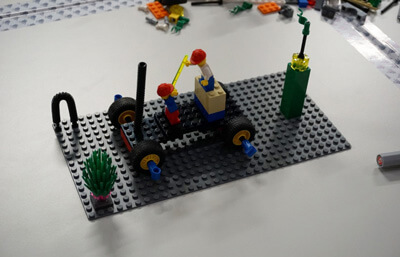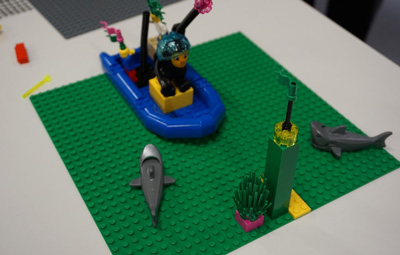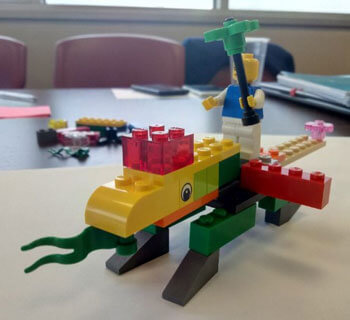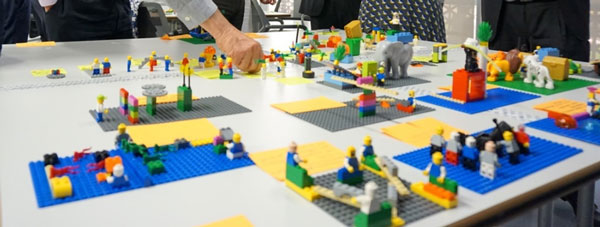
Is your organization ready for or going through a cultural change? Did you know you can use LEGO®s to facilitate your transformation? It might sound a little elementary, but through my experience as both a participant and a facilitator of LEGO® Serious Play® (LSP) workshops, I am convinced of their usefulness and unexpected power in a professional environment!

However, I often run into a common hurdle when discussing LSP as a tool to facilitate change – it is perceived as just a game and a frivolous exercise. Seriously, LEGO® SERIOUS PLAY® is a method designed to increase performance and innovation in companies. By building models using LEGO® parts, this method aims to facilitate decision-making and team cohesion.
LSP is based on construction with LEGO® pieces. Therefore, it uses a common language that everyone understands and can use. Its only requirement is knowing how the pieces fit together.
The LSP method is designed to allow 100% of the attendees to participate 100% of the time. All attendees have the same weight and the same level of involvement in the meeting – no matter if you are at the top or the bottom of the chain. This requirement allows more perspectives, and thus results in greater confidence and commitment.
“If you do not know what to build, just start building.” Under this simple rule, it is possible for unconscious knowledge to emerge. It is estimated that we are only aware of 5-10% of the knowledge we possess. The visualization of objects in 3D, together with the use of metaphors and stories to represent difficult concepts, allows participants to reflect appropriately, learn fast and more complete, and obtain more concrete and effective results.

LEGO® construction is not improvised in LSP, but follows a complete structure based on a central process and different application activities that progress in difficulty. The focus is always to start from the individual vision and to then share with the group. This structure, along with good facilitation, allows participants to quickly connect with the session objectives and conclusions within the time allotted for the workshop, which can range from 2h to several days.
By requiring participation from people with different visions and perspectives, LSP has a unique way of making innovative solutions to problems more obvious. LSP seeks adaptation to complex and changing environments (systems). The focus therefore is not to predict, but to pay attention.
LSP can greatly help organizations in situations where there is no single, shared solution and when different visions need to be shared to create a complete vision. For example:
I would like to explain a couple of concrete experiences with LEGO® associated with its potential to promote cultural changes.
Goal: The goal of this workshop was to improve the service provision of a department to its internal clients. Specifically, to focus less on optimizing internal work and more on meeting the needs of its client to advance together.
To carry out the workshop, we invited people from the department itself AND people from other departments to provide insight on what they expected from their internal provider.
Conclusions / Lessons Learned: Through LSP, we were able to get a complete and shared picture of the current situation (strengths and weaknesses) and the desired client/provider relationship model. From this, we produced a roadmap with initiatives to be executed in order to move from the current situation to the desired future state.
The main learning point was around mutual knowledge, empathy, and understanding that everyone needed to contribute in order to improve. In addition to the service area initiatives, the group even developed improvement initiatives for the client areas. The participants also obtained concrete actions for abstract ideas that were shared during the workshop.

Goal: This experience was for an organization looking to improve their internal processes. Of note, this was not a formal LSP workshop; instead, we utilized a LEGO® activity to gain insight on a major challenge they were facing – overcoming a perceived culture of “silos”. This was actually more than just a perception – each business area had its own objectives and area of expertise, and they approached conversations with other departments in a “we” vs “them” context. Sound familiar?
As part of the workshop, we used dynamic role play. We asked participants to exchange roles (ex. the finance people did operations work). They were to follow the work processes for their “new role” but apply them to building a dragon.
Conclusions / Lessons Learned: By working with LEGO®s, participants were able to get away from their day-to-day work and focus on the relationships between departments. Through the power of empathy, they realized how the role of some departments was only to “provide pieces” – because of this, they didn’t feel connected or committed to the final result (“dragon”).
They also realized that sometimes they didn’t have enough information to carry out their role in building the dragon – the information hadn’t flowed properly between the departments. We detected many other inefficiencies, especially at the level of approvals and deadlines defined in the process.

Once these points were identified, improvements and initiatives were proposed based on what was lived in the LEGO® experience. Most importantly, they understood the importance of working as a team and how to put a new team-based mindset into practice.
As a final reflection, I would like to give some ideas about when it is worth using LEGO®s to promote cultural changes:
We summarized all of this in an infographic for quick reference!
Gracias,
— Alfred

© Copyright 2023. Netmind. All rights reserved.
Por favor, proporciona la siguiente información para ayudarnos a personalizar la solución.
Netmind España
Barcelona +34 933 041 720
Madrid +34 914 427 703
Nos puedes encontrar de:
Lunes – Viernes, 9:00-18:00 (GMT+1)
¡Te ayudamos!
info@netmind.net
¿Dudas sobre servicios/formaciones?
comercial@netmind.es